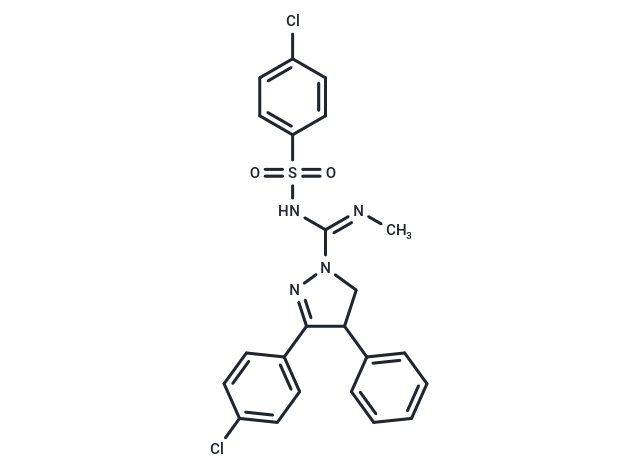Shopping Cart
- Remove All
 Your shopping cart is currently empty
Your shopping cart is currently empty

(±)-Ibipinabant ((±)-SLV319) has been utilized in clinical trials for the treatment of obesity and type 2 diabetes.

| Pack Size | Price | Availability | Quantity |
|---|---|---|---|
| 5 mg | $43 | In Stock | |
| 10 mg | $83 | In Stock | |
| 25 mg | $167 | In Stock | |
| 50 mg | $308 | In Stock | |
| 100 mg | $446 | In Stock | |
| 200 mg | $619 | In Stock | |
| 1 mL x 10 mM (in DMSO) | $47 | In Stock |
| Description | (±)-Ibipinabant ((±)-SLV319) has been utilized in clinical trials for the treatment of obesity and type 2 diabetes. |
| Targets&IC50 | CB1 :22nM |
| In vitro | Cannabinoid receptor 1 (CB1R) antagonists are promising for obesity treatment, but adverse effects limit clinical use. Ibipinabant is a potent [Ki (CB1) = 7.8 nM] and selective [Ki (CB2) = 7.943 nM] CB1 antagonist, demonstrating in vitro properties similar to rimonabant, including inverse agonism, brain penetration[3], and high affinity [pA2 for arachidonic acid release in CHO cells = 9.9]. |
| In vivo | Ibipinabant (3 mg/kg) significantly lowers unfasted glucose levels compared to rimonabant at equivalent doses on days 17, 28, and 38. Long-term ibipinabant administration notably slows diabetes progression in ZDF rats by moderating the rise in blood glucose and HbA1c levels over time. Additionally, ibipinabant decreases the evident hyperinsulinemia at 6-8 weeks of age and mitigates the sharp decline in insulin levels occurring 1-2 weeks thereafter[3]. |
| Animal Research | Rats: SLV319, rimonabant and rosiglitazone are suspended in a 10% dimethylacetamide, 10% cremophor, 10% ethanol and 70% water vehicle. Drugs are administered by oral gavage in a volume of 2 mL/kg body weight at 09:00 hours every day. Treatment groups are as follows: (i) Vehicle: ad libitum access to food (vehicle), (ii) Vehicle: restricted access to food (20% less than average food intake of ad libitum vehicle-treated group for the first 3 days of the study, then 10% less than the average food intake of the ad libitum vehicle-treated group for the remainder of the study) (restricted), (iii) Rosiglitazone (4 mg/kg), (iv) Rimonabant (3 mg/kg) (RIM 3 mg/kg), (v) Rimonabant (10 mg/kg) (RIM 10 mg/kg), (vi) SLV319 (3 mg/kg) (IBI 3 mg/kg) and (vii) Ibipinabant (10 mg/kg) (IBI 10 mg/kg). Rosiglitazone is used as a positive control for its ability to delay β-cell decline, and rimonabant is used as a positive control for CB1 antagonism[3]. |
| Alias | SLV319, (±)-SLV319, (±)-BMS6462 |
| Molecular Weight | 487.4 |
| Formula | C23H20Cl2N4O2S |
| Cas No. | 362519-49-1 |
| Smiles | C\N=C(\NS(=O)(=O)c1ccc(Cl)cc1)N1CC(C(=N1)c1ccc(Cl)cc1)c1ccccc1 |
| Relative Density. | 1.38 g/cm3 (Predicted) |
| Storage | Powder: -20°C for 3 years | In solvent: -80°C for 1 year | Shipping with blue ice. | ||||||||||||||||||||||||||||||
| Solubility Information | DMSO: 45 mg/mL (92.33 mM), Sonication is recommended. | ||||||||||||||||||||||||||||||
Solution Preparation Table | |||||||||||||||||||||||||||||||
DMSO
| |||||||||||||||||||||||||||||||

Copyright © 2015-2025 TargetMol Chemicals Inc. All Rights Reserved.